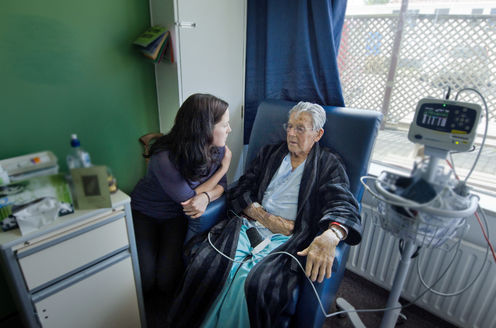
Hospitals dominate our health-care system and account for more than one-third of Australia’s A$150 billion-plus health budget. Pressure is growing on hospital services and costs are spiralling. This is because of the introduction of new technologies and equipment, changing patterns of disease, demographic pressures and a shift in focus from care to cure.
With very few exceptions, the physical configuration, operation, financing and culture of today’s hospitals reflect the practice of medicine and patient populations of a bygone era.
It’s not surprising, then, that hospitals pose many challenges to those who want to reform the health-care system. The general public and politicians who control health budgets view hospitals as icons of the taxpayer-funded health-care system.
But while intensive, high-tech hospital care remains an essential aspect of the health system, patients can now receive care in a raft of other settings. For many patients, a traditional hospital may not be the best place for their care.
Do you really need to go to hospital?
Spending substantial time immobilised and lying down can affect nearly every system in the body. This deterioration of physical and mental functions can mean the difference between dependence and independence for older patients, and slower rehabilitation for younger patients.
A Canadian study published in 1996 estimated that patients did not require acute (hospital-style) care in anywhere from 7% to 51% of adult hospital admissions.
A later study from the United Kingdom found that one in four hospital patients would be better treated with community-based services.
Modern primary care teams – consisting of general practitioners, practice and community nurses, and allied health providers – now assume full clinical responsibility for a growing list of conditions that would traditionally have been administered in hospitals, such as intravenous antibiotics for infections and community-based pneumonia.

The National Health and Hospitals Reform Commission found that, in Australia, 10% of all admissions and 70% of bed days (an overnight stay in hospital) could be avoided if patients had access to responsive, high-quality and well-structured alternative care.
Hospital alternatives
How do you identify patients who might be suitable for alternative forms of care? On what basis would this be done, where and when and by whom? This requires the development of suitable guidelines, well-defined protocols and patient assessment panels to undertake this work.
The list of alternative forms of care includes:
- hospital-in-the-home
- community hospitals
- rehabilitation centres
- respite care
- aged care
- hospice and palliative care
- home visits and support.
The provision of such care requires an appropriate workforce of well-trained-and-equipped multidisciplinary teams. We should investigate innovative initiatives such as teams of GPs, specialists, nurse practitioners, allied health providers, pharmacists, social workers and community nurses working together to visit and care for patients in their homes or residential facilities.
One imperative should be that care comes to the patient, rather than vice versa. It makes little sense to expect sick patients to travel for what are often multiple appointments. Treating patients on their “home ground” can also ensure awareness of cultural and socioeconomic issues and support for carers.

There are clearly challenges and costs involved, but there will be off-setting savings, improved outcomes for patients and (hopefully) job satisfaction for the health-care professionals involved.
The harder questions are those around availability of these services, which level of government pays for them (local, state, federal, or insurers) and how families and patients can coordinate care across different health sectors.
There is also some indication from the UK’s National Health Service that many substitutes for hospital care seem to increase the overall demand for services and have little impact on hospitals. Planning must keep this risk in mind.
Patient choice
Alternatives to hospitals carry the risk of becoming cost-driven substitutes rather than outcome-driven innovations. The likelihood that cheaper, rather than better, care will be substituted for a hospital stay increases for patients who are vulnerable because of age, poverty or diminished mental capacity.
It follows that acute care alternatives should be universally available and affordable to the appropriate patients. Their provision is not about refusing needed admission to hospital or discharging patients “quicker and sicker”. Nor is it about expensive concierge medicine. It’s about putting what’s best for the patient at the centre of the system.
Australia has made only tentative excursions into putting such ideas into practice. Despite the fact that such initiatives have been underway for several decades, there is not a substantial amount of evidence about what works, for whom and why.
Victoria is the major innovator in this regard. A Victorian study has shown that hospital-in-the-home-type care can be less expensive: in cases where hospital admission is completely avoided, the costs are 38% less.
More importantly, patients have improved outcomes and fewer complications such as infection and delirium.
Rethinking the centre of the health-care system
Delivering substitutes for hospital services will require a major reallocation of resources to community-based and other services. Governments will need to raise the capabilities and scope of practice for primary care professionals and invest in telehealth (clinician-patient phone and video consultation) and home monitoring equipment.
It will require full engagement with patients and their families and carers. And critically, it will require changes in viewpoints and culture from politicians, bureaucrats, the medical profession and the community.
It is easy to cast aside such proposed changes – arguments over federal and state and territory financing alone could doom efforts to failure. But the status quo is not sustainable. Small steps, thoughtfully designed, co-operatively implemented, cleverly evaluated and continually expanded could deliver real benefits for all the stakeholders.
Lesley Russell does not work for, consult, own shares in or receive funding from any company or organization that would benefit from this article, and has disclosed no relevant affiliations beyond the academic appointment above.
